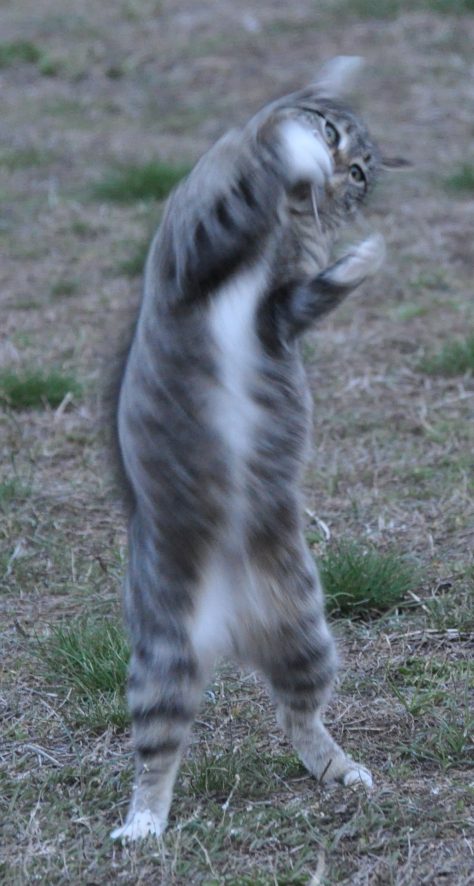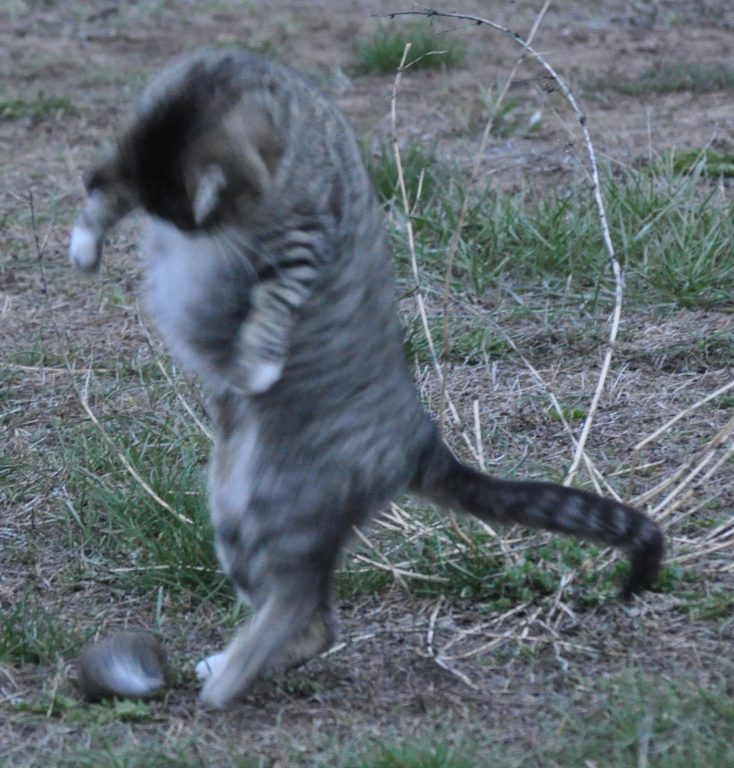Apr 052010
Anyone who thinks that humans have souls but that cats don’t… explain how cats can show so clearly such things as joy. For example, the simple joy of playing with one’s food, as demonstrated Saturday evening (at twilight, explaining the blurriness of the images) by Fingers and her supper.
Insert “You Got Served” joke HERE.
11 Responses to “Dinner and a show”
Sorry, the comment form is closed at this time.











Are there enough mice in the vicinity to make up a significant part part of the cats food needs?
You can tell that getting this one was going to make Fingers’ whole day. 😀
> Are there enough mice in the vicinity to make up a significant part part of the cats food needs?
Yes. This is farming & ranching country. Where there’re farms and ranches, there’s lots of grain and critterchow; and where there’s grain and critterchow, there’s mice and rats. Also a good supply of small snakes and bids, the shredded portions of one I found outside my garage a few days back.
Yep, that is a creature with a soul. We were watching a nature program about monkeys, they kept going on and on about how they are the only animals with”emotions”. What a pile of crap.
And glad to see Fingers doing so well.
A high school English teacher of mine had a cat that developed a taste for bats of all things; it would sit on top of her car all night and swat them out of the air as they were eating moths that were attracted to the garage light.
She’d go out to the car in the morning and find bat wings lying around in the driveway, their former owners now in the cat’s stomach.
That bottom photo looks like Godzilla heading into Tokyo.
“Die, mouse, die!”
Pat
You know, it’s hard to explain this behavior, which all cats share, even regarding things like beetles that they have no intention of eating once they’ve played them to death.
In most animals, including other members of the feline family like the tiger and lion, the idea is to expend as few calories as possible to acquire the prey item, thereby getting maximum benefit from the energy in it.
But the domestic cat seems to go out of its way to use up a great deal of unnecessary energy in playing with its prey, which makes one wonder why this behavior evolved.
Is it to keep up the cat’s muscle tone and reaction time via exercise?
Let it study its standard prey item’s behavior under pursuit so that it will be able to catch future ones with greater assurance?
Or just letting out its frustration that all of its food isn’t as challenging to acquire as the mouse is?
One gets the feeling that cat food suspended from elastic bands would be a big hit with the cats.
The most plausible explanation I have seen is that all members of order Carnivora–the mammalian predators–are hard-wired to enjoy hunting behaviors. It stimulates the pleasure centers of their brains. More so for family Felidae, and domestic cats have been selectively bred for skillful and enthusiastic control of rodent populations for at least four thousand years.
Cats do this because they’ve been bred to do it, they enjoy it very much. I have read, though, and noted with my own cats as well, that you will see much more of the “playing with their food” behavior in cats that don’t get to hunt very often. Cats that get to hunt and kill stuff frequently are a lot more… businesslike, for lack of a better word, than those who (for example) only get to chase a laser dot or a dangly string toy when their pet human thinks to play with them.
Pat? Over the years I have been to National Zoo a lot, love the cats, of course, and I have watched them, especially on cold mornings, playing in much the same way cats do. I have wondered if it has to do with being in captivity, low levels of strenuous activity perhaps that brings on this kind of activity.
One incident that has always stuck with me was a Bengal Tiger playing with a beer keg. She was batting it all over and it went in the moat, floating just out of reach, and the wind was pushing it towards her. She kept reaching out with a paw and it would move away, the wind would push it back. She did that for over 20 minutes, didn’t stop till the wind moved it in another direction, then she jumped out and rolled it up with all 4 legs, splashed around a bit, and then pushed it to the edge with her head and popped it out on the ground, then walked away and ignored it.
And people call them dumb animals.
So I take it opinion is tending toward #3, that this is some sort of frustration behavior that is a lot more likely to be encountered in captivity than in wild specimens?
According to a cat book that I read, the cat’s hunting behaviour is instinctive, but the killing part has to be learned.
So, most domestic cats never learn how to kill properly, but know how to hunt.
Therefore, when prey presents itself, the hunting instinct is stimulated, the cat hunts and catches the prey, but then doesn’t know what to do next.
So the cat lets the prey go, which then, of course, promptly tries to escape.
This stimulates the cat’s hunting instinct again, and the cycle repeats…
> this is some sort of frustration behavior that is a lot more likely to be encountered in captivity than in wild specimens?
I see this behavior regularly in cats that have never known a minutes captivity.